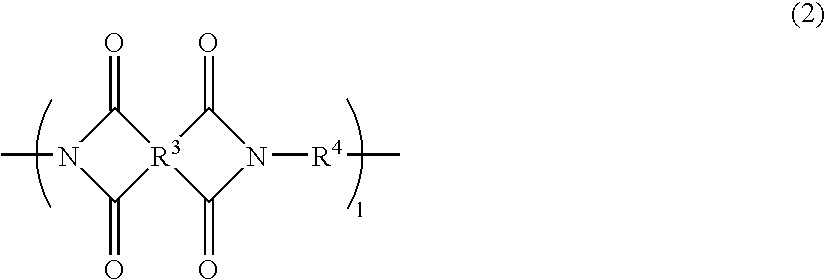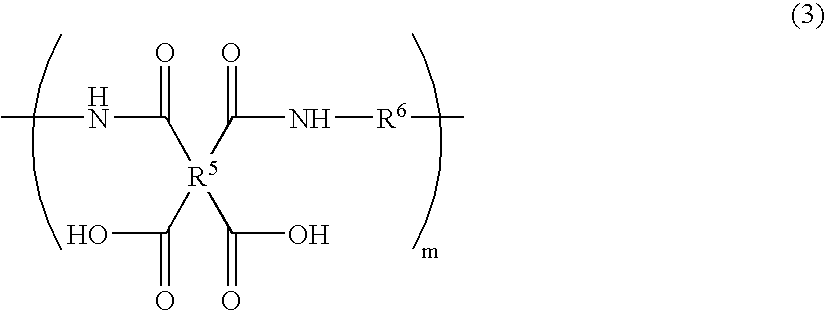Positive photosensitive polyimide resin composition
a polyimide resin and positive technology, applied in the direction of photosensitive materials, instruments, photomechanical equipment, etc., can solve the problems of difficult high-resolution fine processing, cumbersome process, hardly practical, etc., and achieve the effect of reducing viscosity
- Summary
- Abstract
- Description
- Claims
- Application Information
AI Technical Summary
Benefits of technology
Problems solved by technology
Method used
Image
Examples
example 1
Preparation of a Polyimide Resin Composition
2.74 g of 1,3-diamino-5-benzoic acid, 18.16 g of bis[4-(3-aminophenoxy)phenyl]sulfone and 11.53 g of 1,2,3,4-cyclobutanetetracarboxylic dianhydride were reacted in 183.80 g of N-methylpyrrolidone (hereinafter referred to simply as NMP) at room temperature for 6 hours. The reaction solution was diluted with NMP to a solid content of 6.0 wt %, and then, acetic anhydride and pyridine were added, whereupon a dehydration / ring closure reaction was carried out at 40° C. for two hours. This solution was put into methanol, followed by filtration and drying to obtain a polyimide powder (A) having a number average molecular weight of 38,000 (k=70 as calculated by repeating units). The reduced viscosity was 1.0 dl / g (at a concentration of 0.5 g / dl in N-methylpyrrolidone at a temperature of 30° C.).
Further, 5.52 g of p-phenylenediamine, 3.39 g of 4-octadecyloxy-1,3-diaminobenzene and 18.02 g of 3,4-dicarboxy-1,2,3,4-tetrahydro-1-naphthalenesuccinic dia...
example 2
A solution of a positive photosensitive polyimide resin composition was obtained in the same manner as in Example 1 except that in Example 1, 0.20 g of the solution having the polyimide powder (C) dissolved in γ-butyrolactone to a resin concentration of 15%, was changed to 1.05 g (the polyimide powder (C) based on the total weight of all polymers was 5 wt %). Using the prepared solution of the positive photosensitive resin composition, a coating film having a thickness of 1.65 μm was obtained in the same manner as in Example 1. As a result, formation of a pattern was confirmed at the portion irradiated with a light exposure of at least 400 mJ / cm2. The film thickness after the development was about 1.65 μm. The pattern resolution was such that the pattern was formed up to a line / space of 5 μm without peeling of the pattern. The obtained film was heated in a circulating drying furnace at 170° C. for 30 minutes and at 250° C. for 60 minutes to obtain a polyimide pattern having a thickn...
PUM
| Property | Measurement | Unit |
|---|---|---|
| Temperature | aaaaa | aaaaa |
| Percent by mass | aaaaa | aaaaa |
| Percent by mass | aaaaa | aaaaa |
Abstract
Description
Claims
Application Information
 Login to View More
Login to View More - R&D
- Intellectual Property
- Life Sciences
- Materials
- Tech Scout
- Unparalleled Data Quality
- Higher Quality Content
- 60% Fewer Hallucinations
Browse by: Latest US Patents, China's latest patents, Technical Efficacy Thesaurus, Application Domain, Technology Topic, Popular Technical Reports.
© 2025 PatSnap. All rights reserved.Legal|Privacy policy|Modern Slavery Act Transparency Statement|Sitemap|About US| Contact US: help@patsnap.com



